These projects will test the waters and pave the way for others.
Author: IGNAS
Translation: Deep Tide TechFlow

The issuance speed of new tokens has slowed down, but I believe it will accelerate soon because
The market is slowly recovering.
Many projects can no longer delay.
These projects will test the waters and pave the way for others. In this article, I want to highlight some protocols that frequently appear in my X feed. However, it seems that not everyone is familiar with their functions.
A year ago, I wrote a similar blog post about the top 7 projects and planned to publish these articles more frequently, so feel free to subscribe.
Therefore, if you are one of those followers on X waiting for the launch of tokens and airdrops for projects that are being hyped (but don’t really understand their functions), then this article is for you.
Initia - Multi-Chain Eden
Initia is the first sale conducted by Cobie's Echonomist group on its Echo fundraising platform.
Cobie's team has only conducted three project financings, which may make the situation bullish. The mainnet and airdrop should be launched soon (although it seems to be delayed until April).
If there is one word you should understand about Initia, it is "interwoven."

Initia is an L1 that integrates L2 to create a modular network of application chains.
It sounds like Ethereum, but Initia addresses the issues that ETH maxis dislike about Ethereum.
Unlike isolated Ethereum L2s, Initia merges Layer 1 with Layer 2, creating a mutually interwoven ecosystem. They refer to these L2s as Minitias. It is also similar to Avalanche subnets (recently renamed to L1).
Unlike Ethereum but similar to Avalanche, the OPinit Stack supports EVM, MoveVM, and WasmVM. Therefore, developers can use any language they find suitable.
This may make ETH bulls drool. Initia's Enshrined Liquidity allows for the separate staking of INIT tokens or approved INIT-X LP tokens (paired with INIT) to earn rewards in a Delegated Proof of Stake (DPoS) mechanism.
Fixed liquidity is a good representation of Ponzi token economics, forcing 50% or more of INIT to be used as pairing tokens for all ecosystem tokens. These LP tokens must be whitelisted by governance.
Like Berachain, Initia also has a native dex: InitiaDEX built on L1 using the Move programming language. It is the liquidity hub of the Omnitia ecosystem, and as I understand it, most liquidity will flow through InitiaDEX (and through the mandatory INIA pool) even between L2s.
Initia has more features, such as native bridging (confusingly named Minitswap) and a vested interest program (rewarding new use cases created by applications and INIT), but the four features mentioned above stand out to me.
Initia truly incorporates the demands of Ethereum natives into a product, making it a mutually interwoven ecosystem.
Tokens and Financing
Tokenomics has not been fully released. Initia only shared four details about it:
50% of the supply is allocated for VIP and Enshrined Liquidity
Insiders have no unlocked staking rewards
Community round discount of about 30%.
15% for investors.
We can expect an airdrop, as Initia co-founder Zon said, “Vesting unlocks are a gift. They prevent you from giving up too early and force you to believe.”
In September 2024, Zon also shared with Block about Initia's last round A funding, raising $14 million from companies like Theory Ventures, Delphi Ventures, and Hack VC, with an FDV of $350 million.
The testnet is incentivized, so feel free to visit the official testnet website to obtain testnet tokens and participate in its ecosystem. All information can be found on the testnet page here.
As always, I don't have high expectations for testnet activities.
Overall, the ecosystem is well-built. The key question remains: will builders and users choose to participate?
Fogo - The Fastest L1 Blockchain
Fogo is another project conducting a token sale within Cobie's own Echo group, raising $8 million at a $100 million valuation.
Fogo uses the highly optimized Solana validator client Firedancer created by Jump Crypto as the only execution client on the network.
It hasn't even launched on Solana yet. Solana will soon benefit from the Firedancer client, but not all validators can switch to it immediately. This means the network speed is limited by the slowest nodes.
As Fogo co-founder Doug Colkitt said: “It’s like having a Ferrari, but you’re driving it in congested traffic in New York City.”
Under optimal conditions, their theoretical speed can reach 1 million transactions per second, with a block time of 20 milliseconds, but Fogo's real-time developer network has achieved about 54,000 TPS. In comparison, Solana's current theoretical limit is 65k TPS, but it is currently achieving 4.3k.
The MegaETH testnet pushes 20k TPS with a 10-millisecond block time.
In contrast, TradFi systems can handle over 100,000 operations per second with sub-second latency.
The Fogo team believes that decentralized networks must match institutional-grade use cases such as high-frequency trading and instant payments.
It runs the Solana Virtual Machine (SVM), which means developers can easily migrate Solana applications, tools, and infrastructure to Fogo without any changes. A series of forks with shiny new tokens (Jupiter, Kamino, Pumpfun, etc.) are expected.
Clearly, not everyone in the Solana ecosystem is pleased about this.

Notably, Fogo's contributors include members of Douro Labs, the team behind the Pyth oracle network, which is closely related to Jump Crypto.
Other notable features:
Multi-Local Consensus (“Follow the Sun”): Fogo groups validators into semi-independently working geographic “regions.” Control rotates regularly to the next region, preventing any single location from dominating. This means consensus can be reached faster during normal operations, as messages do not always have to travel around the globe. Read more about it here.
It will initially have a selected group of validators (20-50) at launch.
Fee abstraction: Transaction fees can be paid in any token.
Tokens and Financing
Fogo raised about $5.5 million in a seed round led by Distributed Global, with CMS Holdings also participating. This is the highest amount in the $8 million financing raised by the Echo group.
Devnet is set to launch by the end of 2024, with the testnet coming soon and the mainnet expected to launch in mid-2025. Currently, there is little information about tokens or airdrops.
Succinct - Proving the Software of the World
“Cryptocurrency has failed to fulfill its mission.
We were promised a transparent, verifiable, trustless global coordination system. However, what we got were bridge hackers, multi-signature L2s without fraud proof, and a committee of 21 validators controlling billions of dollars."
This is the main problem that Succinct is addressing.
“ZK proofs are one of the most critical technologies for blockchain scalability, interoperability, and privacy, but they are too complex for most developers today.”
It’s hard to get excited about ZK proofs right now, but Succinct caught my attention with its excellent marketing campaign and its testnet/website dashboard as a MacOS interface.
You can play games and earn points.
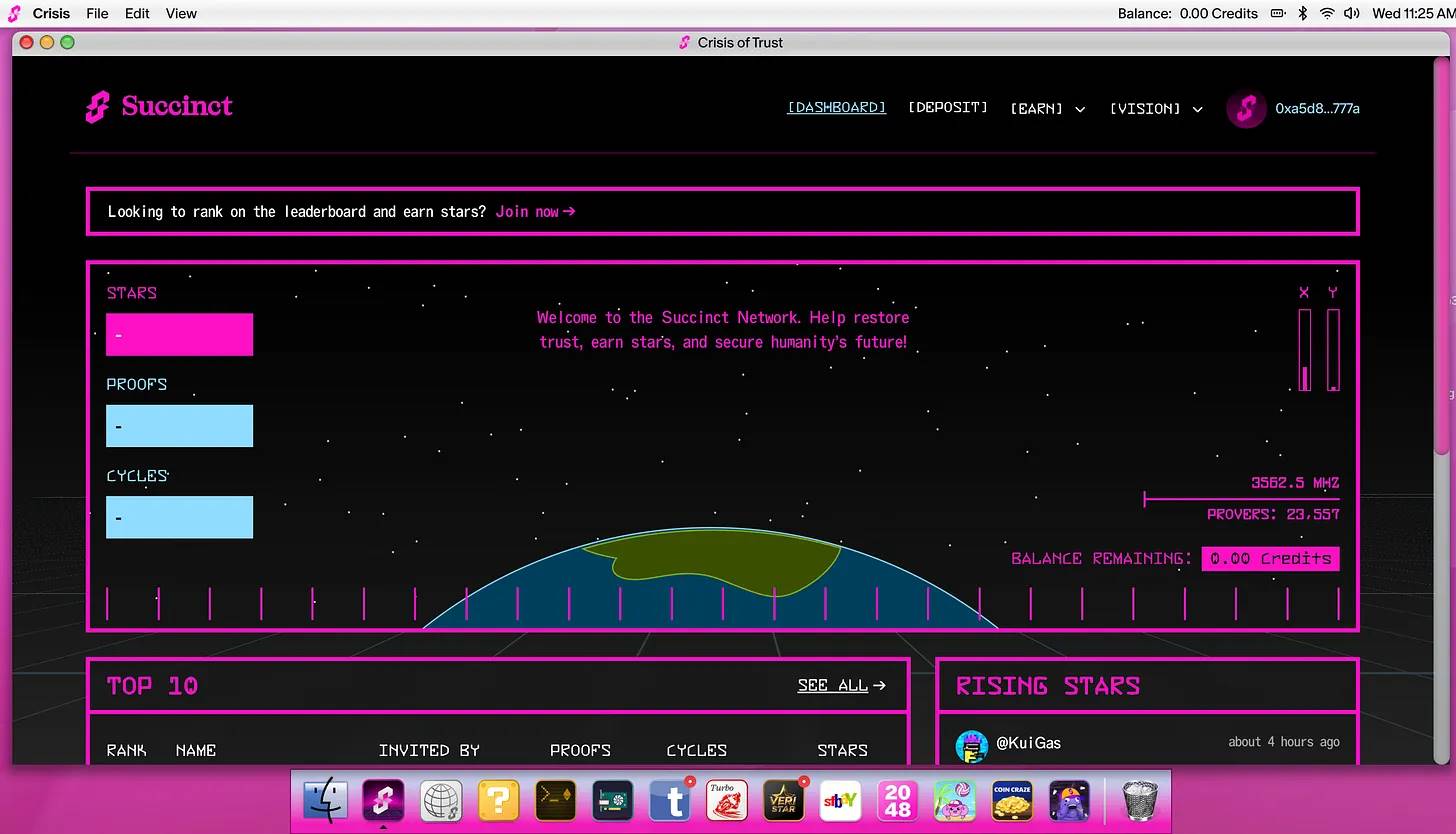
Anyway. The problem we face now is:
Each project must build its own proof system (for example, zkSync and Scroll use zero-knowledge for scaling, but the infrastructure is fragmented.)
Many rely on centralized providers to generate proofs.
This is not only costly but also slows down the pace of innovation.
As a result, succinct ZKPs (a technology that proves authenticity cryptographically without revealing data) are difficult to implement due to fragmented infrastructure and high costs.
Succinct offers a shared proof generation market, so that each project doesn’t have to reinvent the wheel. Developers can focus on building applications (aggregators, bridges, oracles) while outsourcing proof creation to the network.
Notable partners: Polygon, Celestia, Avail, Gnosis.
But the use cases are more diverse, such as private voting systems or anonymous transactions. Or you can prove that you have money in your wallet without actually showing how much.
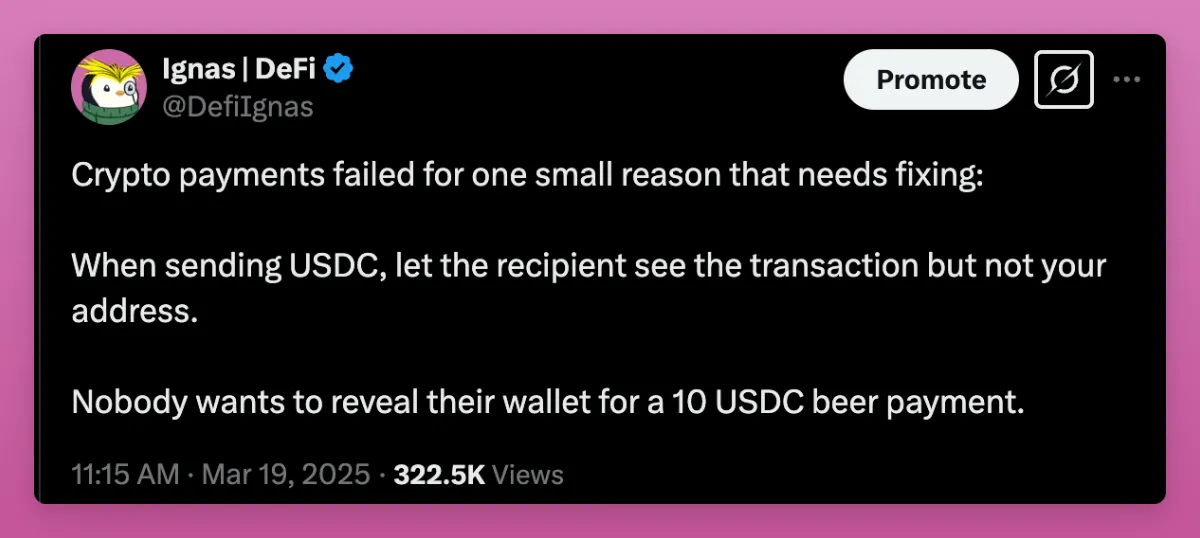
This is a technical project, but it could become the glue that decentralizes and protects the most vulnerable crypto projects.
Their testnet, “Level One: Trust Crisis”, launched two months ago. You can earn stars by generating zero-knowledge proofs. You need a $10 USDC deposit to cover the proof generation costs. But to get an invitation code, you need to farm it on platforms like X, Discord, etc.

I think this will be the standard for airdrops, but details about the tokens have not been publicly disclosed yet.
Succinct raised $55 million, led by Paradigm, with participation from Robot Ventures, Bankless Ventures, Geometry, and others.
The TGE is expected to come soon after the mainnet launch.
Resolv - A Truly Effective Delta-Neutral Stablecoin
Many people now believe that the next altcoin rally will be driven by increased institutional adoption, especially in stablecoins.
The problem is that the main beneficiaries of stablecoin adoption seem to be institutions and stablecoin issuers, while retail investors may only get a little benefit.

I wrote some thoughts on protocols that might benefit from stablecoin adoption, but I want to add one here—Resolv.
If you know how Ethena works, then you already have a good foundation for understanding Resolv.
The core idea of both is the same—using crypto collateral plus short-term perpetual hedging to create stablecoins. However, Resolv's architecture and approach differ:
First is the dual-token model versus the single-token model: Ethena has a single-token model (USDe), where all risks and rewards flow to stablecoin holders and are managed behind the scenes by the protocol's reserves.
Resolv uses a dual-token model (USR + RLP), which explicitly isolates risks into a separate token.
USR: Like USDe, USR maintains its peg by shorting futures to hedge ETH prices, adopting a delta-neutral strategy. You can stake USR to earn yields, converting it to stUSR, similar to a savings account.
RLP acts as insurance for USR, absorbing losses to keep USR stable (for example, when financing rates are negative). RLP holders take on risks for higher returns. The value of RLP fluctuates with the protocol's performance, acting as a buffer: it grows with profits and shrinks with losses.
This setup allows risk-tolerant users to earn more while protecting stablecoin users from market risks. As of this writing, USR's APR is 4.3%, and RLP's is 6.7%.
While not too high, the airdrop point farming has allowed Resolv to achieve a TVL of $636.9 million. Not bad.
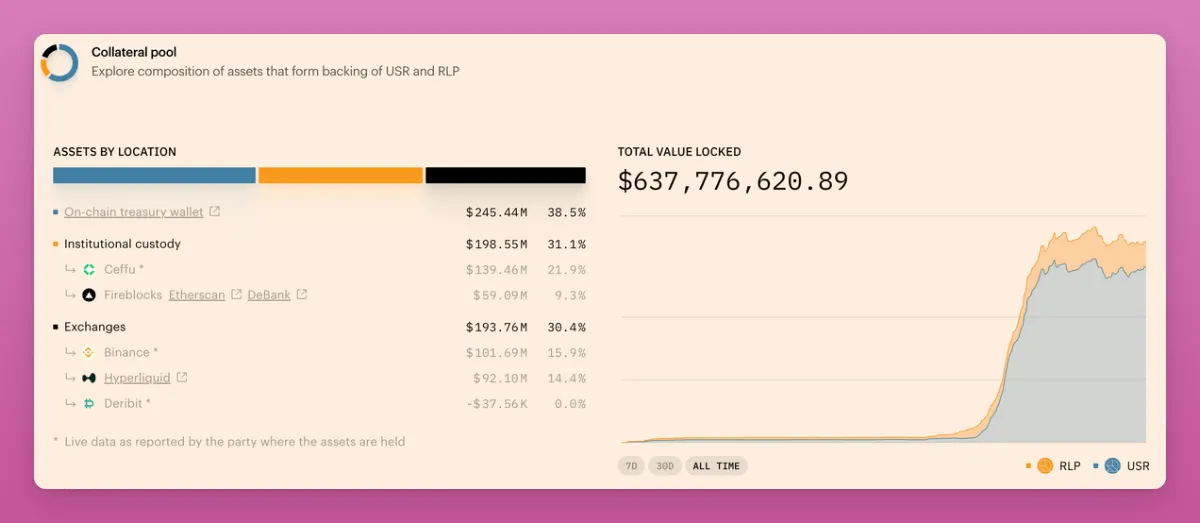
Secondly, Resolv's philosophy is to maintain 100% cryptocurrency backing. All collateral is ETH (support for BTC was just announced), with no involvement of RWA.
Initially, Ethena only supported cryptocurrencies, but later introduced a secondary stablecoin, USDtb, which is 90% backed by BlackRock's tokenized money market fund (BUIDL).
For Resolv, USDtb is somewhat of an insurance token similar to USR, designed to stabilize USDe during bear markets by providing traditional asset yields when cryptocurrency yields decline.
Thus, you could say Resolv is more “crypto-native” and is spiritually decentralized, even though Ethena's strategy can gain additional stability by introducing centralized assets.
Tokens and Financing
Resolv has not officially disclosed financing details, but supporters include Delphi Labs, Daedalus, and No Limit Holdings. They are preparing to launch community financing through Legion soon.
Starting in September 2024, Resolv will begin running a points program. You can still join by depositing stablecoins and earning points.
After depositing, you can maximize points through Pendle pools or other strategies.
The token $RESOLV is expected to launch in early 2025.
Snapchain - Possibly the Largest Consumer L1
What I’m most concerned about is whether Fogo, Initia, and other chains being launched will be adopted? What killer applications will be launched on them? As Kyle said:
“General-purpose blockchains will die. Each blockchain needs a specific use case, and they will be defined by the content built on them.”
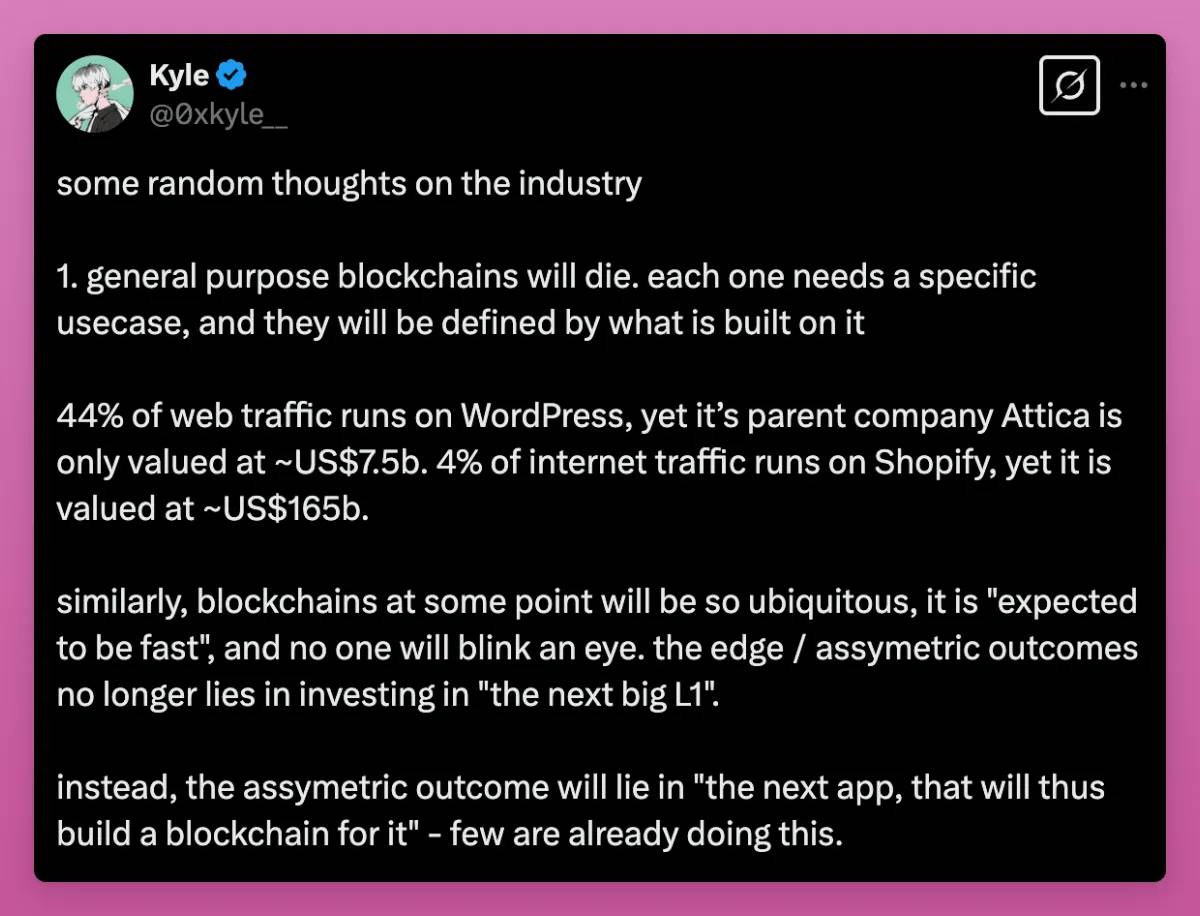
This is where Snapchain, an L1 built for the Farcaster social network, comes into play.
Snapchain is necessary because decentralized social networks struggle to stay in sync and provide real-time updates as they scale. Lens will use zkSync technology, but Farcaster is developing its own technology.
“For example, Twitter has 200 million users daily, processing 10,000 messages per second, and the state’s data could grow at a rate of 1TB - 10TB per day.”
Farcaster's current system runs on a small scale, but as users and nodes increase, it will fail. Snapchain will fix this issue in a decentralized manner.
At launch, it should support 9k+ TPS, thereby supporting 2 million daily users (currently around 50k DAU).
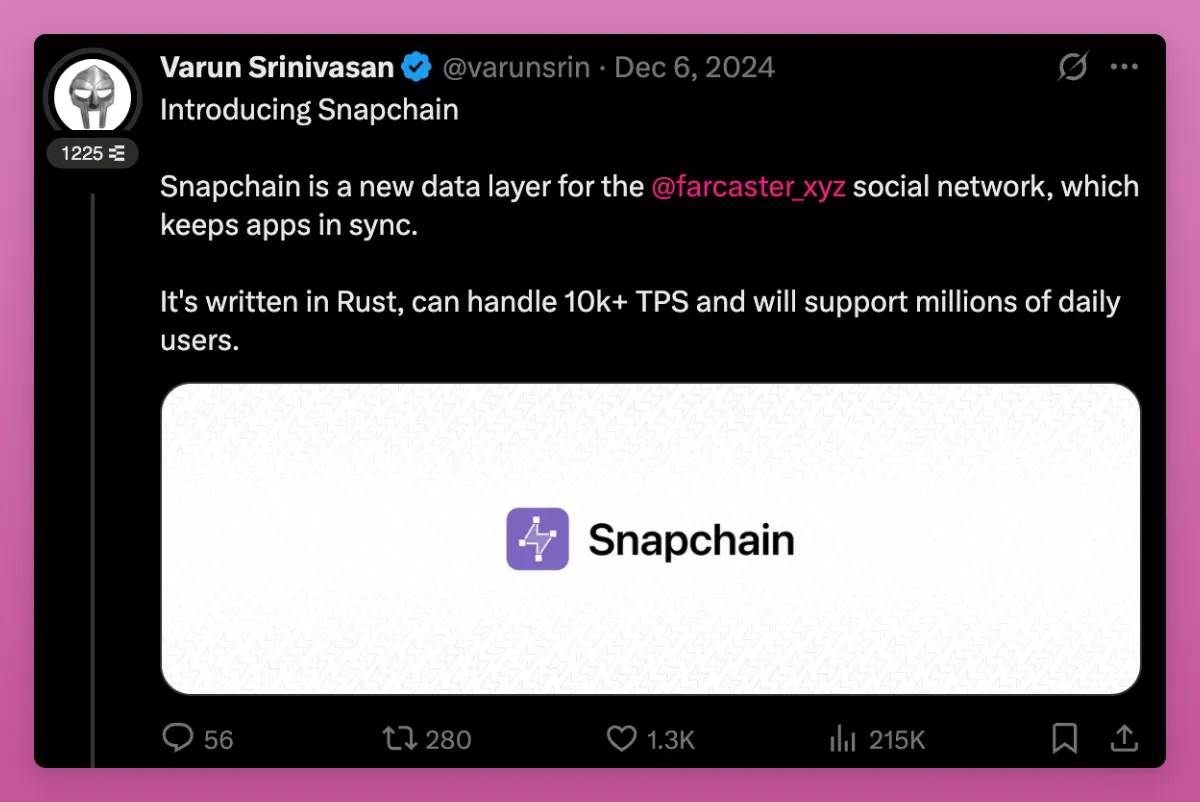
I won’t focus too much on the technical details, but there are two exciting parts:
First, data deletion (trimming), haha. On the blockchain, most data needs to be permanently stored, but what if you post a meme and immediately regret it? It must disappear! Forever.
Thus, on Snapchain, once old data (posts, likes, follows) is no longer needed, it can be deleted.
This is important because users can pay $2 or $3 a year for 500 tx/hour and about 10,000 tx storage limits.
So, if you delete old transactions, it opens up storage space for new transactions (or you need to pay more fees).
The second cool part is sharding. Remember that Ethereum considered sharding before moving to layer 2 scaling.
Imagine putting all social media transactions (likes, posts, etc.) on-chain. There are millions of transactions daily. If every node has to store and process everything, it will lag. Every full node needs to process every transaction, even if it doesn’t affect them. This is fine for money and smart contracts, but it’s not scalable for real-time social interactions.
Snapchain solves this problem by making each user completely independent (when you register on Farcaster, you get an ID number, and if your ID number is low, then it’s a bragging identity). Your posts don’t affect my account.
Thus, Snapchain will distribute users across multiple shards (by the way, this is inspired by the Near model). Each shard only processes its users. This means more users = more shards = higher throughput.
To keep all content in sync, there’s a final layer: bundling shards and publishing a global block on the main chain.
Ethereum cannot easily do this. Its transactions rely on shared state—smart contracts, tokens, balances. This makes account-level sharding difficult.
Snapchain is effective because social behaviors are simple. They only affect the sender.
There’s more content you can read here, but I’m optimistic about Farcaster and Snapchain because it first builds use cases and then adds blockchain to them.
It works well for Hyperliquid; even with 50k DAU and 900k total users, Farcaster remains one of the top consumer applications.
Tokens and Financing
TLDR: The Genesis block is already online, and the mainnet is expected to launch on April 15, 2025. So it’s coming soon.
I believe that once Snapchain is live and Farcaster is ready to scale, Coinbase x Farcaster will start announcing integration with the Coinbase wallet.

This is a big deal. Social media information on the Coinbase wallet? I’m serious.
However, I’m not sure when the tokens will launch; the team has been silent about it, but some rumors and funding announcements might indicate it’s coming soon. Snapchain itself is a technical component, not an independent entity raising funds. The development of Snapchain is funded by the company Merkle Manufactory, which builds the Farcaster protocol.
Most notably, in May 2024, they announced a $150 million funding round led by Paradigm, with other major investors like a16z crypto, Haun Ventures, USV, Variant, and Standard Crypto also participating.
Bonus: Two More Projects for You: Eclipse and Atlas
I originally planned to write about the 7 major TGEs and protocols, but this article is too long. I always get carried away (often deleting 30% of the content before publishing!)
Eclipse and Atlas are two more SVM (Solana VM) chains on Fogo.
Eclipse is an Ethereum L2, but it uses SVM instead of EVM and utilizes Celestia for DA. It is already live, but the total locked value is only $57 million. As Kyle mentioned (in the tweet above), this shows how difficult it is to differentiate from other general-purpose chains.
A standalone SVM is not enough to distinguish itself from other L2s.
The token seems to be confirmed as code ES:
E - Ethereum
S - Solana
Atlas is another Ethereum-based L2 SVM, but it is built specifically for on-chain order books, margin systems, and high-frequency trading. So it needs speed! The testnet is already live.
Since I know you want to get back to surfing on X, here’s more information about Eclipse and Atlas provided by Blockworks.

免责声明:本文章仅代表作者个人观点,不代表本平台的立场和观点。本文章仅供信息分享,不构成对任何人的任何投资建议。用户与作者之间的任何争议,与本平台无关。如网页中刊载的文章或图片涉及侵权,请提供相关的权利证明和身份证明发送邮件到support@aicoin.com,本平台相关工作人员将会进行核查。




